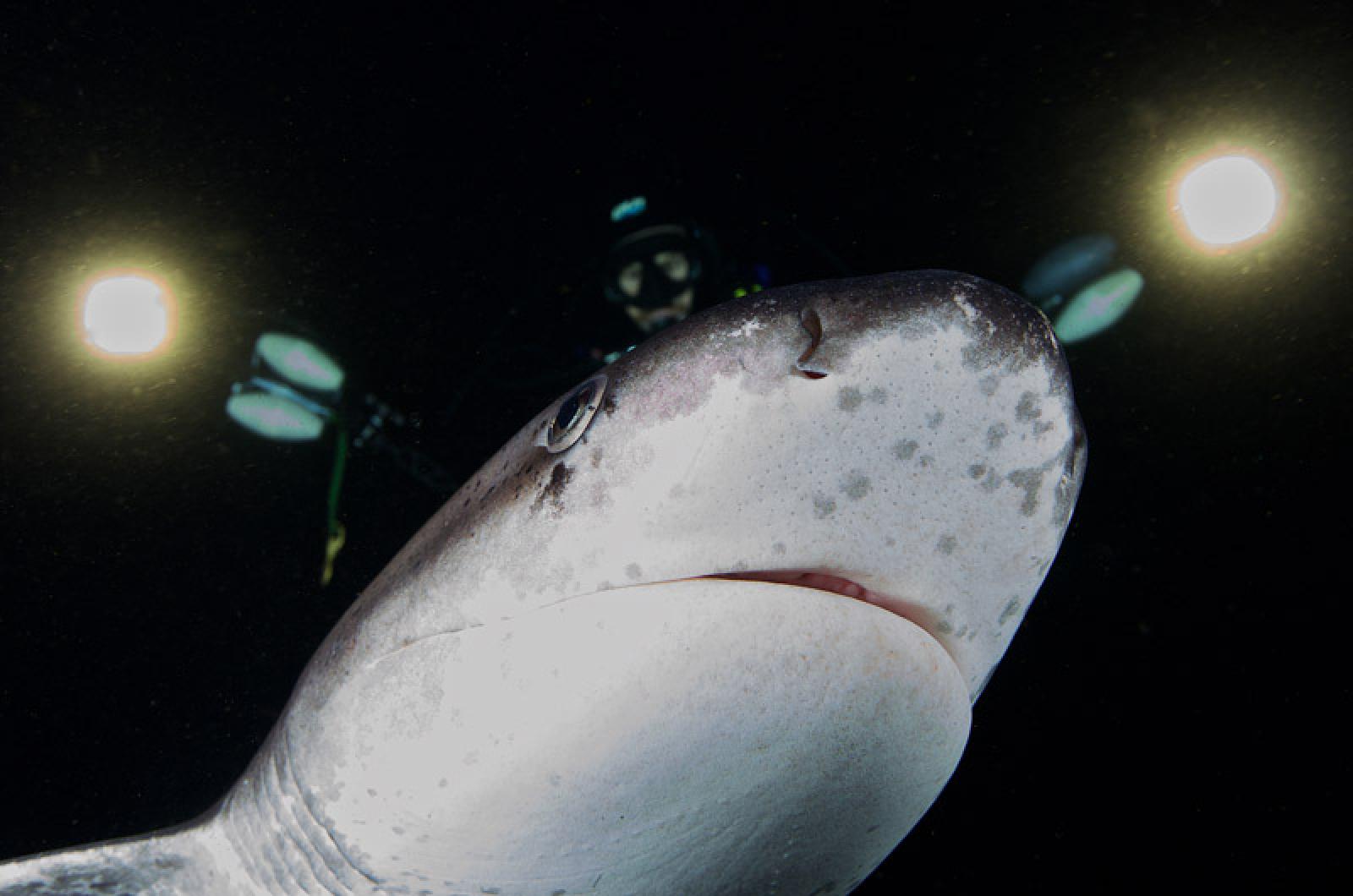Plunging into shark-filled waters where just a few years ago a scuba diver was bitten on the head may sound like a nightmare, but for Chilmark summer residents Adam Geiger and Colette Beaudry, it’s just another day of work. Together the husband and wife film producing team have worked on hundreds of environmentally-minded shows, especially marine films.
Their latest project, Sharks of the Shadowland, will premiere on Discovery’s Shark Week Friday night.
The show, executive produced by Ms. Beaudry and filmed, directed, written and produced by Mr. Geiger, will take viewers deep into the fiordlands of New Zealand, called Ata Whenua in Maori, meaning Shadowland. This is where sevengill sharks have been making a curious appearance in the past few years. Three scuba divers commissioned by the Department of Conservation regularly dive at the site to manage and remove an invasive species of seaweed called Undaria. Jenny Oliver, the marine biologist who was bitten in 2012, shark researcher Kina Scollay and Ross Funnell are all featured in the episode, along with sneaky, six-foot sevengill sharks, whose pack mentality can make them more fearsome than some larger species.

“It’s not the Bahamas, it’s not a holiday,” said Ms. Beaudry, speaking about the Shadowland in an interview with her husband on Wednesday morning at their Chilmark family home. “It’s really heavy rain and cold and dark and murky waters, but these workers go there and the sharks have become more and more curious to aggressive in the last year or so. So really, Discovery Channel in their interest in these sharks and this story, gave us the platform to go in and really study the sharks, and see if there are patterns to protect the divers who go in there every month. Because if it gets too dangerous and the divers stop diving, the weed will take over and an ecosystem will die.”
Because of the steep fjords in the area, there is never full sunlight in the water, hence the name shadowlands.
“[The shadows] add to the moodiness of the thing; it’s spooky to be in shadowy water with sharks cruising around, looking for you,” said Mr. Geiger. No matter how many times he dives with sharks, Mr. Geiger does not grow complacent in his dealings with them.
“I wouldn’t say that I’m scared of them. I respect them tremendously, I think they are gorgeous, I think they are vital to the health of our oceans, and I love being in the water with them,” he said. “But I’m always aware that it’s their world and they’re the boss really.” He said sharks give off certain clues when they become agitated and experienced divers know to back off. Flattening of the pectoral fins and arching of the back are signs that it’s time to get out of the water.
And filming underwater involves more than dealing with potentially deadly megafauna.
“When you take a camera underwater, you have two problems, one of which is survival and the other of which is applying all of those [above ground photography] skills in a medium that is quite different,” Mr. Geiger said over a steaming mug of tea. Ms. Beaudry said being an excellent above-ground photographer and an excellent diver do not necessarily add up to being an excellent underwater photographer.
“It’s a whole third realm of skill set really,” she said. “What I used to find funny sometimes when I would light for Adam is the current, because I would have to keep the light steady in one spot and sometimes you have a surge going back and forth and you kind of have to move your light against the current in a funny little dance.”
Light acts differently underwater, oceans can be murky with particulates, above water weather can affect a shoot — in short, a whole realm of concerns must be considered for underwater camera operators.
Mr. Geiger has been diving since 1970, spending his first underwater explorations in Menemsha Channel, though he completed his certification off Island. An underwater camera that his parents bought him for his birthday piqued his interest in photography in general. Today, his idea of relaxation is to shoot still photos underwater, as opposed to video. Both Mr. Geiger and Ms. Beaudry have degrees in science and storytelling.
“[I thought] there was no way to make a living as a photographer especially an underwater photographer,” said Mr. Geiger, “So I went to school and got a degree in marine science and said gee, I really don’t want to work as an scientist, I want to make underwater films! So I went back to film school briefly for an associate’s degree, in Santa Barbara. And I haven’t really looked back.”

Ms. Beaudry who studied journalism in addition to an environmental science degree, would always volunteer for the marine stories in her early television career, which led to where she is today. Their production company, Sealight Pictures, is based in Sydney, Australia, the island of Ms. Beaudry’s heart and the couple’s off-Island home. At the company they produce a number of animal-centric and conservation-minded films.
“Overall, we try to let the audience experience and appreciate and respect the natural world,” Mr. Geiger said. “Whether it’s above water or under water, so that they can understand it and hopefully love it and understand why it’s important and why it needs to be conserved. With shark films, we very much want to try and change public perceptions of these animals so that they can be appreciated for their beauty, for the remarkable evolution they represent, and not reviled and not vilified.”
Though there are concerns that Shark Week increases the public fear of sharks, Mr. Geiger said the program is going through a metamorphosis. He compared it to the unintended fear the movie Jaws caused, and how after the film, novelist Peter Benchley and his wife, Wendy, went on to champion sharks and advocate for their protection.
“I think that in a funny way that is sort of what happened for Discovery,” he said. “They’ve gone through a transformation from entertainment and are coming back to documentary. It’s an evolution of programing.”
Ms. Beaudry said more of the fear comes from human instinct than from the shows themselves. Shark shows use primal fears to keep viewers’ attention, and try to shoehorn in the science and majesty of the intimidating creatures, which would otherwise be in danger of being ignored.
“It’s a very tricky topic, because it is their realm and people do get attacked,” she said. “And that does get hyped, by the news and all forms of media; we just hope that people can see that we kill so many millions of sharks every year, where sharks, these amazing powerful creatures that could eat us for lunch, only kill a handful of humans every year. And somehow that fear can just entertain them long enough to watch the show and think about the oceans.”
Mr. Geiger said nobody would watch a film with just beautiful pictures of the ocean, which despite its majesty would quickly become boring. He called it a balancing act.
“There has to be an entertainment value to it,” he said. “And that becomes the tricky job of the filmmaker, to find a way to tease people’s interest enough to keep them watching while delivering a more important message about the animal and its role and why it’s important.”
The husband and wife team fell in love during filming for a show about venomous nocturnal cobras in Lake Tanganyika in Tanzania, bonding over a mutual dislike for the show’s host.“We hoped a snake would bite him,” joked Mr. Geiger.
“We’ve certainly had our challenges,” said Ms. Beaudry. “But I think if we’ve survived everything we’ve survived, including working together, I think were pretty unbreakable.”
For this show, they worked with a small team. Mr. Scollay contributed to filming and producing as well as appearing on screen with Ms. Oliver and Mr. Funnell. Mr. Scollay’s wife, Caroline Foote, helped write the script. Anthony (Ant) Nevison was the sound recordist, cook and gear manager, Chris Sammut was the boat driver, still photographer and data wrangler and it was all edited by Michael Drake.
Sharks of the Shadowland will premiere at 9 p.m. on the Discovery Channel on Friday, July 10.




Comments (2)
Comments
Comment policy »